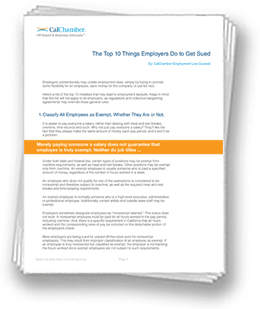California Overtime Laws
Understanding and Calculating California Overtime Pay

California overtime rules and exceptions benefit employees more so than corresponding federal regulations.
Common Mistake
Not paying required overtime premiums.
Basic California Overtime Pay Requirements
For almost all nonexempt private sector California employees who are not covered by collective bargaining agreements, California laws for overtime pay are based primarily on the number of hours worked in a day. However, you must also account for weekly totals when calculating California overtime.
Calculating California Overtime
The trickiest part of payroll administration is calculating overtime. You should use a step-by-step approach to comply with the state of California overtime pay laws:
- Identify those hours that must be paid on an overtime basis;
- Decide whether you need to pay time-and-one-half or double-time for those hours; then
- Determine the "regular rate" you must use to calculate the overtime pay.
Regular Rate of Pay
When calculating overtime pay in California, you must use the employee's "regular rate" of pay — which isn’t always simply an employee's normal hourly amount. The regular rate is a term used to mean the employee's actual rate of pay after all hourly earnings and other types of compensation are considered, such as commissions, production/nondiscretionary bonuses and piece rates. The regular rate must include nearly all forms of pay received by that employee (but certain payments, such as expense reimbursements and discretionary bonuses, are excluded).
Weekly Overtime
Only hours worked at straight-time apply to the weekly 40-hour limit. This prevents "pyramiding" of overtime, where an employee earns overtime on top of overtime already paid.
Salaried Nonexempt Employees
California Overtime Example
Calculating daily and weekly overtime in California can be quite confusing. Below is an example that shows the proper overtime calculations for one common situation.
-
Sample: Sarah S. Swingshift Sarah works the swing shift, usually starting work at 8 p.m. each evening and working into the morning of the next calendar day. Thus, each shift is partially in one workday and partially in another, as her employer uses 12:01 a.m. to 12 midnight as its "workday." Sarah's shift begins on Sunday night, the first day of the seven-day workweek used by her employer. Even though Sarah works a nine-hour shift (with a 30-minute meal break), the first four hours are on Sunday, and the remaining five hours (12 a.m. to 5:30 a.m.) are on the second workday — Monday. When Sarah returns to work Monday night, the first four hours are included in her time for Monday, and the next five hours on Tuesday. For any day in which Sarah works more than eight hours, she will be entitled to overtime for hours worked in excess of eight. To avoid the confusion caused by working on two workdays each shift, her employer might change the definition of the workday and workweek for employees on the swing shift, perhaps making their workday run from 8 p.m. to 7:59 p.m. each day, with a workweek starting at 8 p.m. on Sunday.
Overtime Exceptions for Specific Industries in California
The Wage Orders, along with various California statutes, contain certain exceptions to the general rules for calculating overtime and premium pay for specific industries, including agriculture, domestic work/personal attendants, hospitals, transportation, residential care and many others. If you are in one of those industries, familiarizing yourself with the exceptions can help you avoid penalties and may even save you money.
Mandatory Overtime Restrictions for Specific Wage Orders
Generally, employees have no legal basis to refuse working overtime in California. However, there are exceptions under certain specific Wage Orders or a company policy or union contract addressing the subject. Employees may also have to be accommodated in terms of refusing overtime hours due to disabilities and religious needs. Under some Wage Orders, there are limitations on the actual amount of overtime you may require employees to work.
Related Resources
CalChamber members have access to several tools and services to help those who manage human resources work through California overtime pay-related issues, including:
Overtime Calculation Worksheet »
Use this form to calculate pay for your nonexempt employees.


